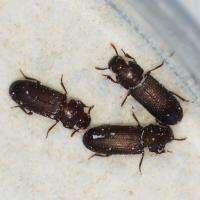Invasive Species on the March: Variable Rates of Spread Set Current Limits to Predictability

(PhysOrg.com) -- Whether for introduced muskrats in Europe or oak trees in the United Kingdom, zebra mussels in United States lakes or agricultural pests around the world, scientists have tried to find new ways of controlling invasive species by learning how these animals and plants take over in new environs.
In a paper published in this week's issue of the journal Science, biologists Brett Melbourne of the University of Colorado and Alan Hastings of the University of California at Davis report a previously unknown high variability in the rates of invasive species spread.
To reach their conclusions, they studied red flour beetles--beetles attracted to wheat flour--in experimental, enclosed landscapes with patches of habitat linked together.
They collected data from 30 landscapes composed of identical patches of land, all maintained under the same conditions, each initially home to 20 red flour beetles.
Although the landscapes were identical, there were considerable differences in how the beetles spread. By the end of the 13-beetle-generation experiment, the distance the beetles ranged spanned 10 to 31 "landscape patches."
"Scientists have struggled to understand why some species spread rapidly, while others don't," says Saran Twombly, acting deputy division director of the National Science Foundation (NSF)'s Division of Environmental Biology, which funded the research. "Once ecologists identified the key factors, it was thought, they could predict species spread with some certainty.
"Melbourne and Hastings have showed the opposite: intrinsic variability that could be random or have a genetic basis appears to have a large influence on species' spread. Researchers must now incorporate uncertainty in future approaches to 'ecological forecasting.'"
Everyone's familiar with uncertainty in weather forecasts, says Melbourne. "How often have we heard, 'there is a 75 percent chance of rain today?'"
As in weather systems, there's a degree of unpredictability in ecological systems.
The uncertainty arises because of randomness in both environmental and biological processes. "Ecologists have rarely measured it, however, so we haven't known how big it is," states Melbourne.
"We need to know more about how this affects the specific case of biological invasions," says Melbourne, "and how it changes ecosystem responses generally."
Ecologists will increasingly be called on to make the biological equivalent of weather forecasts: how will ecological systems respond to climate change, habitat destruction and loss of biodiversity?
Will species be able to migrate fast enough to keep pace with climate change?
Although more research is needed, the uncertainty Melbourne and Hastings found may place more species at risk in a changing climate: flora and fauna may not be able to march one step ahead of the pace of global warming.
Provided by NSF















